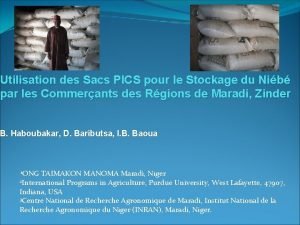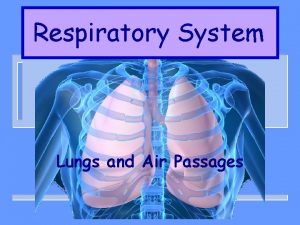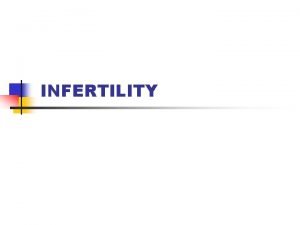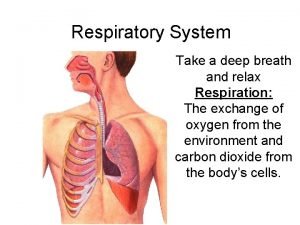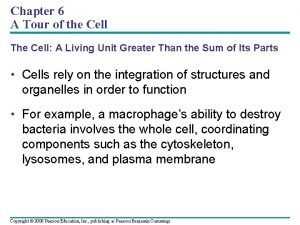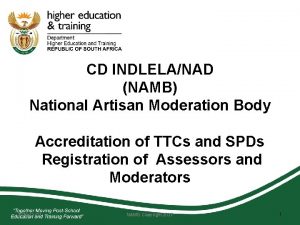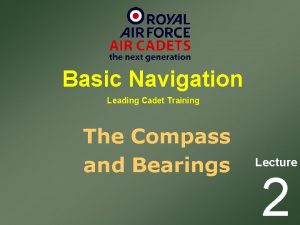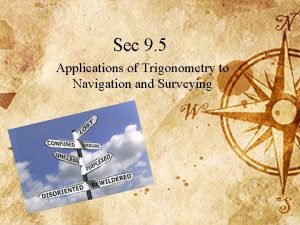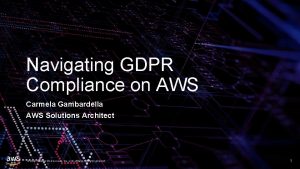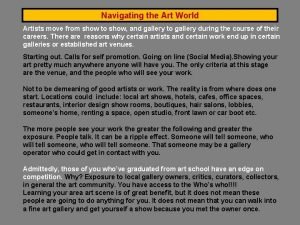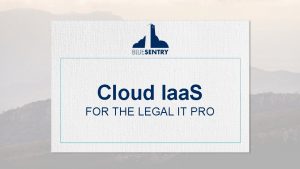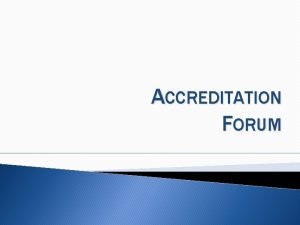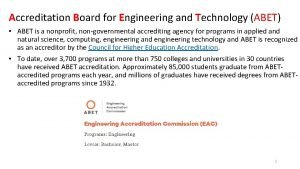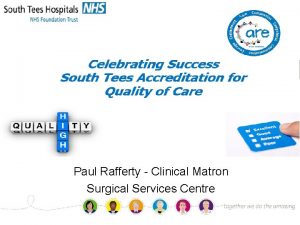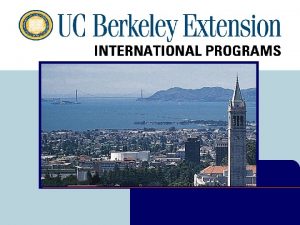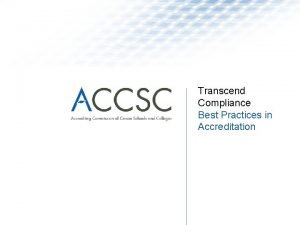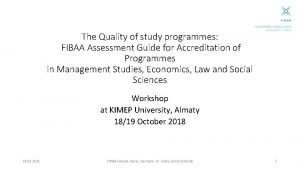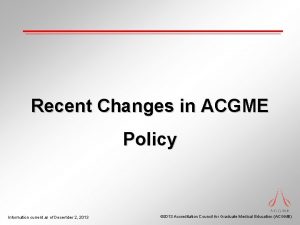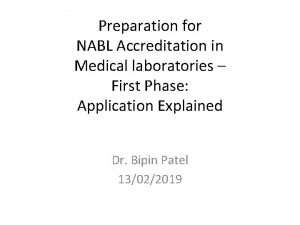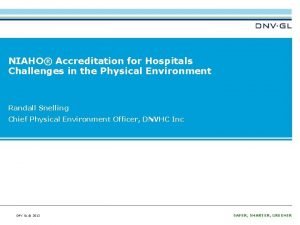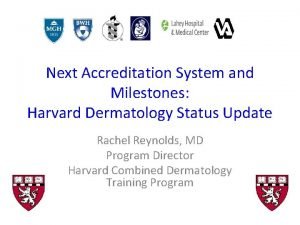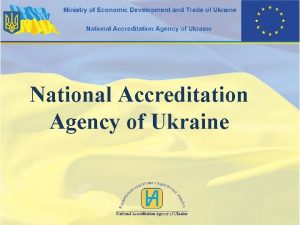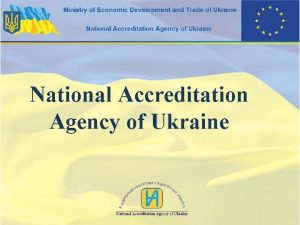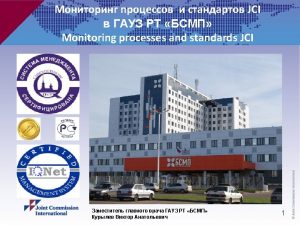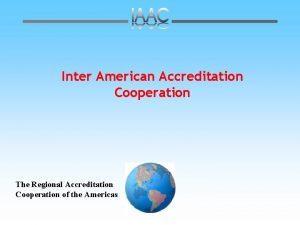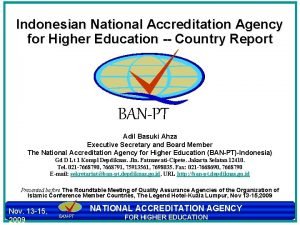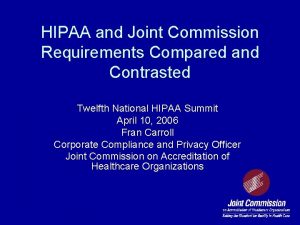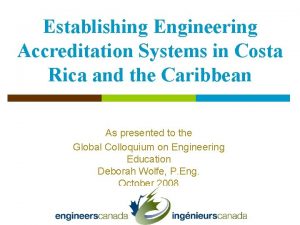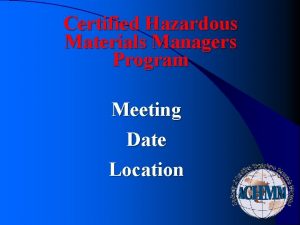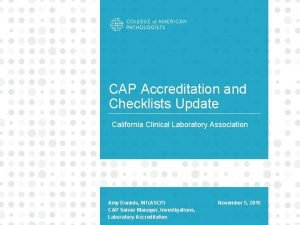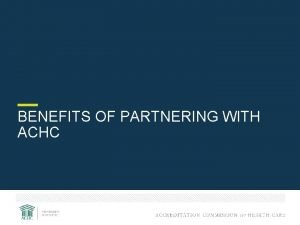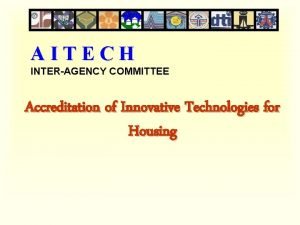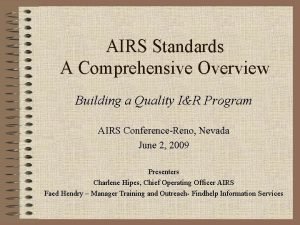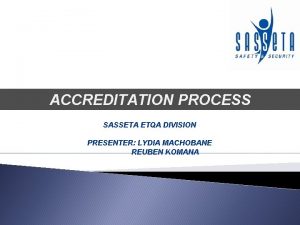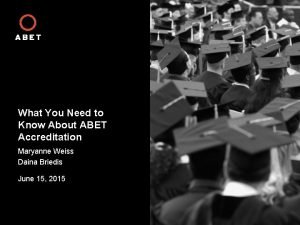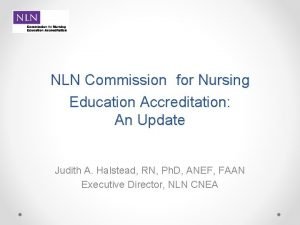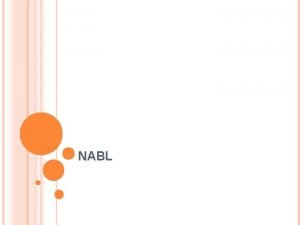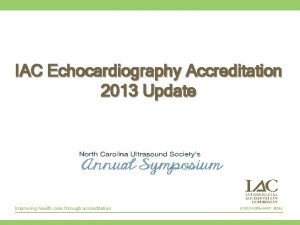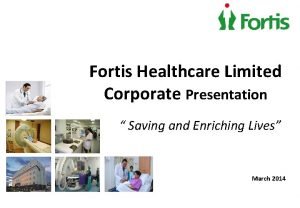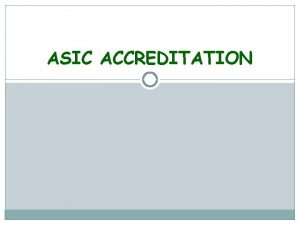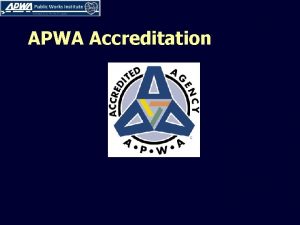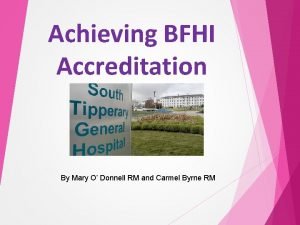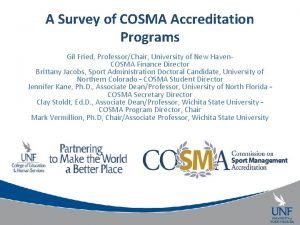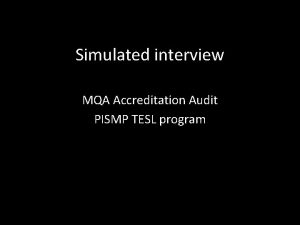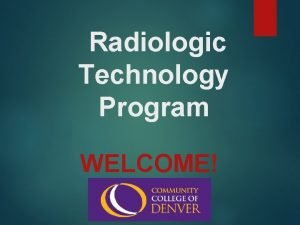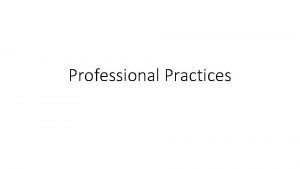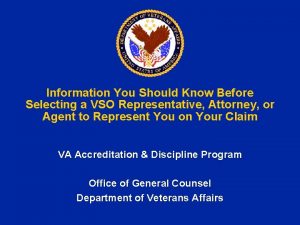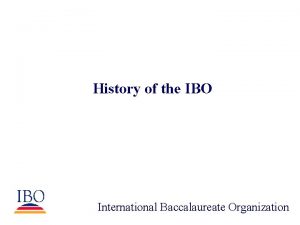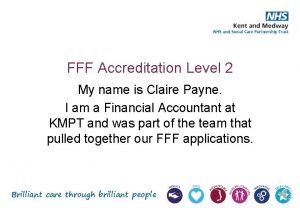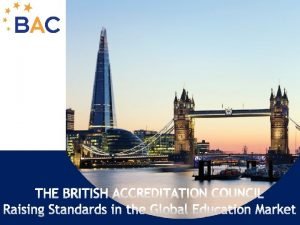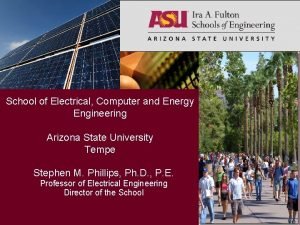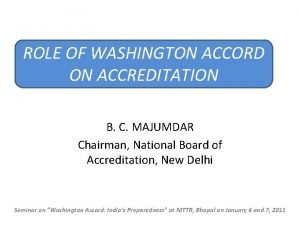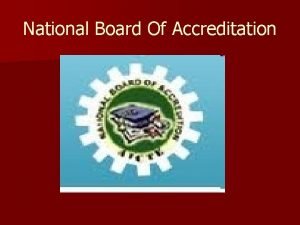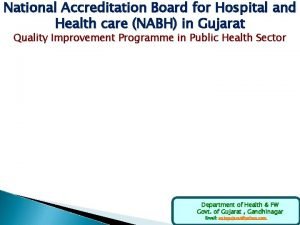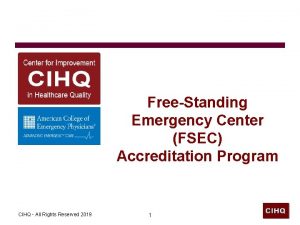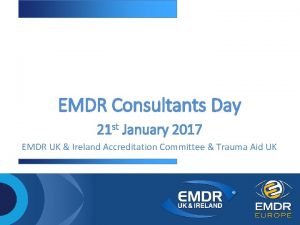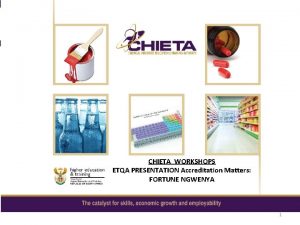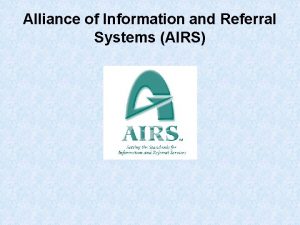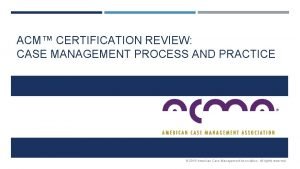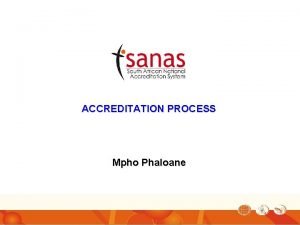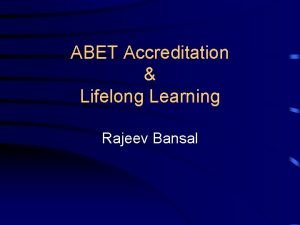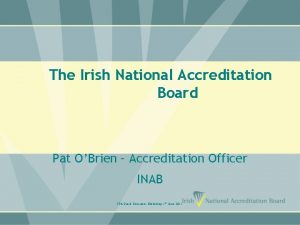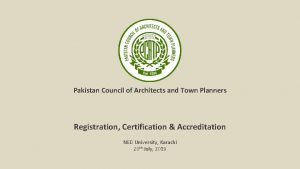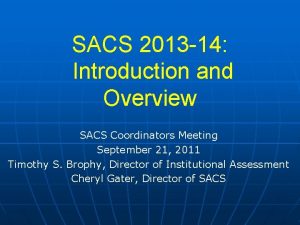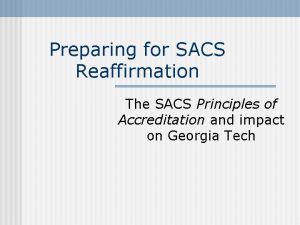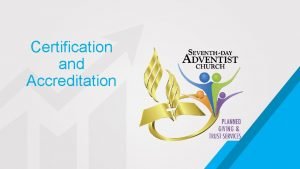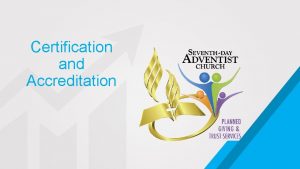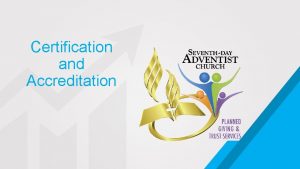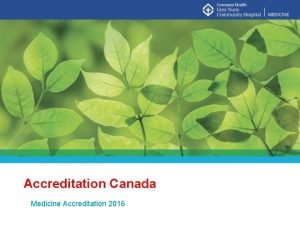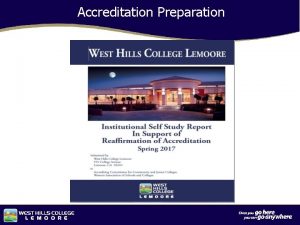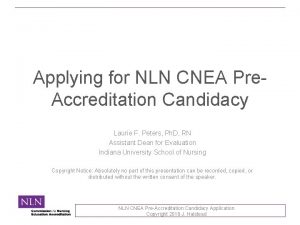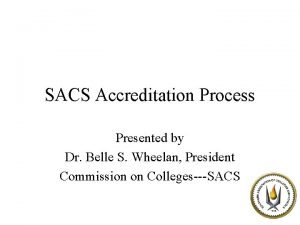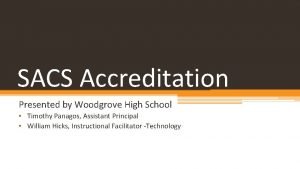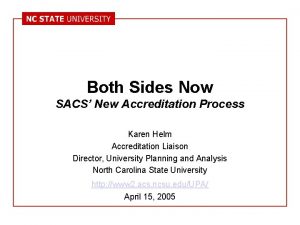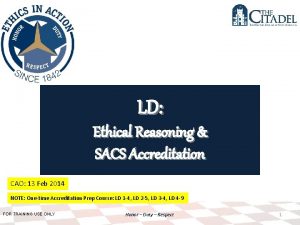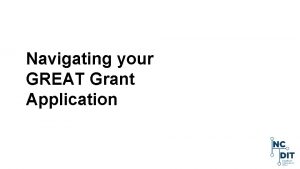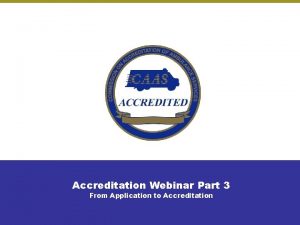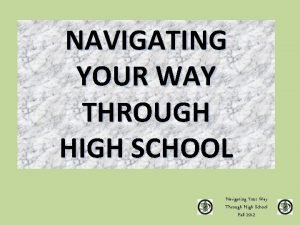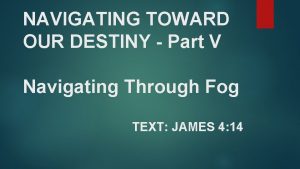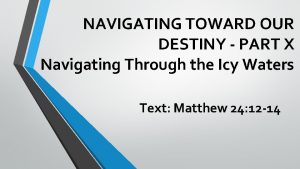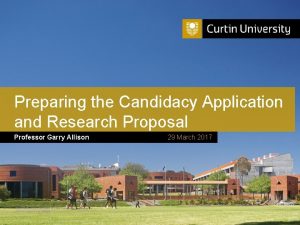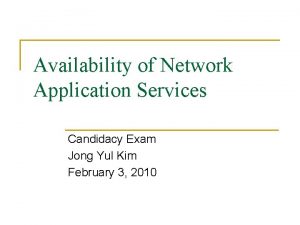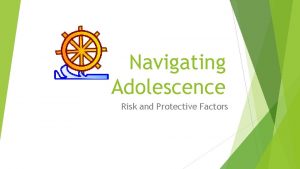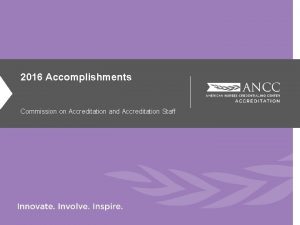Navigating Through a SACS Candidacy Application and Accreditation
















































































- Slides: 80

Navigating Through a SACS Candidacy Application and Accreditation Review A Model for Crafting a Successful Compliance Certification Report

Agenda 1. 2. 3. 4. 5. 6. Introduction and Overview Accreditation Overview Compliance Certification Assessment Basics Strategies for Success Questions, Comments, Conversation

Questions What is Accreditation? Who is SACS?

Basic Purposes of Accreditation • Improve the quality of education a. b. c. d. Student learning The student experience Institutional effectiveness Effective use of resources • Provide accountability a. b. c. d. e. f. g. Students (current and perspective) Employers Parents External funding sources Board of Trustees Transfer institutions Accrediting agencies

The overall goal of the review is to ADD VALUE to the institution Student Benefits: ØEase of transfer ØFinancial aid

Quality GOALS INPUTS PROCESSES Efficiency Effectiveness OUTPUTS/OUTCOMES

Enrollment and Accreditation

What would you do with $10, 000?

SACS Accreditation Outline 1. Compliance Certification a) b) c) d) Integrity Core Requirements Comprehensive Standards Federal Requirements 2. Quality Enhancement Plan 3. Commission Policies

Compliance Certification A. B. C. D. Integrity: 1 Core Requirements: 12(16) Comprehensive Standards: 14(67) Federal Requirements: 9(11) Ø 95 Standards Ø 92 Standards to respond to in CC ØEvidence (meeting minimum standards) ØSigned by President and Accreditation Officer

Compliance Certification Achieving widespread institutional participation for the compliance review is not a goal.

All Compliance Standards Are Not Created Equally Core Requirements have a heightened level of importance.

Compliance Certification Tools üMaster Calendar üResponsibility Matrix üCommunications Plan üSupport from Leadership

Leadership and Division of Responsibility • Compliance Certification ØSmall (influential) group ØAdministrative exercise • QEP ØFaculty led ØRepresentation from all parts of the campus community

The Reaffirmation Process 1. Orientation by SACSCOC 2. Optional Advisory Visit 3. Submission of Compliance Certification 4. Off-Site Peer Review 5. Submission of Focused Report 6. Submission of QEP 7. On-Site Peer Review 8. Submission of Response Report 9. Review by COC

Offsite review is preliminary/advisory. You get three chances to get it right.

Student success is the highest priority.

The “Dirty Dozen” Standards/Requirements Most Often Cited 1. CS 3. 7. 1 Faculty Competence 2. CS 3. 5. 1 College-Level Competencies 3. CS 3. 4. 1 Academic Program Approval 4. CR 2. 11. 1 Financial Resources 5. CS 3. 3. 1 Effectiveness – Expected Outcomes 6. CS 3. 2. 10 Administrative Staff Evaluations 7. CS 3. 4. 7 Consortia/Contractual Relationships 8. CR 2. 5 Institutional Effectiveness 9. CS 3. 7. 2 Faculty Evaluations 10. CS 3. 11. 3 Physical Facilities 11. CS 3. 10. 1 Financial Stability 12. CS 3. 2. 13 Foundation Governance

Comprehensive Standard 3. 7. 1 Faculty Competence ØGeneral policy (must adopt your own) ØException policy ØDocumentation for exceptions ØNeed original transcripts ØMust provide two terms of data ØApplies to all FT and adjunct faculty ØSee SACS’ “Guidelines”

Core Requirement 2. 5 Institutional Effectiveness The institution engages in ongoing, integrated, and institution-wide researchbased planning and evaluation processes.

“The goal of institutional effectiveness planning is not to create more work for everyone but to ensure that the work being done is the best it can be. ”

IE Basics ØStrategic Plan ØAnnual Goals ØIE Plan ØKPIs ØTracking Documents ØUnit Notebooks ØProgram Notebooks ØDocumentation of Use of Results ØAt least two cycles of evidence

TSC Institutional Goals/Priorities I. Pathways II. Success III. Community Engagement IV. Institutional Effectiveness

Institutional Effectiveness: The comparison of results achieved to goals intended.

Planning and Evaluation is required in ALL areas. This is not stated but it is necessary. Need to provide evidence that you use results to make continuous improvements on every level (institutional, program, course, student).

• • • Administrator Dean Chair Program Coordinator Director Faculty Academic Support Staff Student Services Support Staff Administrative Services Support Staff

Comprehensive Standard 3. 3. 1 Institutional Effectiveness The institution identifies expected outcomes, assesses the extent to which it achieves these outcomes, and provides evidence of improvement based on analysis of the results.

The 3. 3. 1 Series 1. Educational Programs 2. Administrative Support Services 3. Academic and Student Support Services 4. Research 5. Community/Public Service

Percentage of institutions cited for non-compliance on CS 3. 3. 1? 1. 66% 2. 56% 3. 46% 4. 36%

3. 3. 1. 1 Program / Student Learning Outcome 1. 2. 3. 4. 5. Assessment Use of Results Methodology Targets & / Results Improvements

3. 3. 1. 1 Program Goal 1. 2. 3. 4. 5. Assessment Use of Results Methodology Targets & / Results Improvements

3. 3. 1. 2 -5 Unit / Assessment Use of Results Department Methodology Targets & / Goal Results Improvements 1. 2. 3. 4. 5.


Avoid the use of “Generic” Success Targets • Increase • Improve • Strengthen • Enhance • Heighten • Elevate

Alignment

Academic Outcomes: Program Reviews (not SLOs) ØProgram Goals ØEnrollment ØMacro Indicators: retention rates, placement rates, transfer rates, licensure, graduates, employer/student/faculty satisfaction, advisory committee notes, etc. ØStudent profile ØProgram demand ØCost-benefit analysis ØCredit and contact hours generated ØProductivity measures

Student and Administrative Affairs Program Review ØUnit mission and goal statements ØStudent profile ØMeasures of demand/traffic/utilization ØEfficiency ØEffectiveness ØContribution and impact ØSatisfaction measures ØCost-benefit analysis ØEnd-of-year Report ØPeer Reviews ØPerformance/quality indicators ØEvidence of continuous improvement

“Sure, the students like your programs and services, but what evidence do you have that what you are doing is making a difference? ”

Comprehensive Standard 3. 5. 1 College-Level Competencies The institution identifies college-level general education competencies and the extent to which students have attained them.

TSC General Education Requirements • • • Communication I (6 hours) Communication II (6 hours) Mathematics (3 hours) Natural Science (8 hours) Humanities/ Visual & Performing Arts (6 hours) History (6 hours) Government (6 hours) Social & Behavioral Sciences (3 hours) Physical Education (4 hours) 48 Total Credit Hours

“Products” of Higher Education 1. Cognitive Development 2. Behavioral Development 3. Affective Development

• Knowledge • Skills • Abilities • Attitudes • Values • Behaviors

SLO = ? 1. 2. 3. 4. 5. Slovenia Student Life Organization Sore Losers Organization Special Liquor Order Student Learning Outcomes

Student Learning Outcomes defined: The knowledge, skills and abilities a student has attained at the end (or as a result) of his or her engagement in a particular set of higher education experiences.

Good learning outcomes are: 1. Learner-centered 2. Key to the course/program mission 3. Meaningful (to students and faculty) 4. Measurable

Remember, student achievement is not the same as student learning.

Tips on Writing SLOs 1. Identify what the student should learn: a. What should the student be expected to know? b. What should the student be expected to be able to do? c. How is a student expected to be able to think? 2. Try to keep the outcomes to a simple sentence. 3. Be as specific as possible. 4. Use active verbs that describe an observable or identifiable action. 5. Identify success criteria (proficiency expected). 6. Think about how you will measure (documentation, artifacts, evidence).

Phrases to Avoid • • • Appreciation for… Acquainted with… Awareness of… Capable of… Comprehension of… Conscious of… Familiar with… Interested in… Knowledge of… Knowledgeable about… Understanding of…

Comprehensive Standard 3. 4. 1 Academic Program Approval The institution demonstrates that each educational program for which academic credit is awarded is approved by the faculty and the administration.

Core Requirement 2. 11. 1 Financial Resources a) Institutional audit b) Management letter c) Statement of financial position of unrestricted net assets d) Annual approved budget

Comprehensive Standard 3. 2. 10 Administrative Staff Evaluations The institution evaluates the effectiveness of its administrators on a periodic basis.


Ø Ø Ø Ø Ø On-Site Mandatory Reviews 2. 8 Faculty 2. 10 Student Support Services 3. 2. 8 Qualified Admin/Acad Officers 3. 3. 1. 1 Institutional Effectiveness 3. 4. 3 Admissions Policies 3. 4. 11 Academic Program Coordination 3. 10. 3 Financial Aid Audits 3. 11. 3 Physical Facilities 3. 1 Policy Compliance 4. 1 Student Achievement 4. 2 Program Curriculum 4. 3 Publication of Policies 4. 4 Program Length 4. 5 Student Complaints 4. 6 Recruitment Materials 4. 7 Title IV Program Responsibilities 4. 8 Distance and Correspondence Education 4. 9 Definition of Credit Hours

Assessment Defined The systemic collection, review, and use of information about educational programs undertaken for the purpose of improving student learning and development – Ted Marchese


Assessment Helps ØReinforce or emphasize the mission of your unit ØImprove a program's quality or performance ØInform planning ØInform decision-making ØEvaluate programs and personnel ØAssist in the request for additional funds ØAssist in the reallocation of resources ØAssist in the meeting of reaccreditation requirements ØCelebrate successes ØCreate a culture of continuous improvement

“Assessment turns colleges from being teacher-centered to be student- and learningcentered”

Basic Questions Guiding Assessment 1. What should students/clients gain from our unit services and experiences? 2. How can we document and evaluate how well we are providing these services? 3. What changes should we make to improve? 4. Do the improvements we make work?

Four Levels of Assessment in the Academy 1. Institutional Level 2. Program / Departmental Level – – – General education Degree programs (major field of study) Developmental education Distance education Continuing education 3. Course Level 4. Individual Student Level

Distance Education (issue of equivalency) Developmental Education (performance in next level course)

Process for measuring outcomes 1. 2. 3. 4. Create written statements of measurable outcomes. Choose the evaluation tool. Set standards for levels of performance on each objective. Identify observable factors that provide the basis for assessing which level of performance has been achieved. 5. Set benchmarks. 6. Evaluate performance, assemble data, and report results. 7. Use results to make improvements.

Non-Academic Evidence: Direct Measures • • • Productivity Metrics Efficiency and Effectiveness Metrics Needs Assessment Ratio and Financial Analyses Utilization Statistics Error Rates Turnaround Time Wait Time Value-added Measures (pre- and post-testing, time-series analyses) • Case Studies and Simulations • Rubrics

Academic Evidence: Direct Measures • • • Comprehensive/capstone examinations or assignments Licensing examinations Professionally judged performances/demonstrations Portfolios (documented learning experiences) Value-added measures (pre- and post-testing, time-series analyses) Standardized tests (i. e. , CAAP, MAPP, CLA) Case studies Simulations Capstone experiences Rubrics

Faculty Concerns • • • “We already assess: grades. ” “This is additional work. ” “I’m too busy. ” “This violates my academic freedom. ” “Degree attainment demonstrates that SLOs are attained. ” • “I don’t know how. ” • “When will this go away? ”

Why aren’t course grades enough? • Issue of consistency between instructors (non-standardized grading practices). • Need meaningful data across sections. • Grades may reflect student behaviors such as class participation, attendance, cooperation, missed assignments, etc.

Evidence – Indirect Measures • • • Client Satisfaction Community Satisfaction Student Satisfaction Alumni Satisfaction Employee Satisfaction Retention Rates Placement Rates (employment or transfer institutions) Focus Groups Exit Interviews Advisory Committee Recommendations Reflective Essays

Structure of Measurements • Employ multiple measures – Quantitative – Qualitative – Formative – Summative • Triangulate results • Establish baseline data – Longitudinal – Comparative • Set realistic goals • Define -> Measure -> Improve

Make friends with your IR/IE staff


Documentation Rule If it is not documented then it did not happen.

SACS Major Changes • College-Level Competencies • Faculty Credentialing (guidelines) • IE: Use of Results (closing the loop) • IE: Student Learning Outcomes • Policy Compliance • Distance Education

Other Areas That Require Attention 1. Institutional Mission (CR 2. 4, CS 3. 1. 1) 2. Number of Full-Time Faculty (CR 2. 8) 3. Qualified Academic/Administrative Officers (CS 3. 2. 8) 4. Control of Intercollegiate Athletics (CS 3. 2. 11) 5. Fund-Raising Activities (CS 3. 2. 12) 6. Academic Program Coordination (CS 3. 4. 11) 7. 25% Rule (CS 3. 5. 2) 8. Representation Status with COC (CS 3. 14) 9. Student Complaints (FR 4. 5) 10. Recruitment Materials (FR 4. 6)

Resources ØSACS ØHandbooks / Monographs ØWebsite: www. sacscoc. org ØLiaison ØCHEA ØWebsite: www. chea. org ØColleagues

Budget ØOn-site team ØTravel ØFood ØHotel ØMisc. ØPrinting & copying ØSurveys ØConsulting ØStipends and release time

Resource Room On-site and at hotel Ø Ø Ø Ø Compliance certification material and documentation Clerical and technical support Computers Internet connectivity Printer Copier and shredder Office supplies Phones (and long distance access codes) Local website Name badges Food and drinks Campus maps On-campus contact information

Application Preparedness Tips The “Top 30” 1. Make effort an institutional priority 2. Start early (catalog and handbook items, credentialing, course and program goals, college rules/policies) and stay on schedule 3. Review material on SACSCOC website 4. Develop a SACS educational campaign for entire college/university community (front & back end) 5. Provide faculty and staff with assistance (assessment) 6. Take a one-college/university perspective (consistency is key) 7. Review and communicate mission statement 8. Prepare for Politics (and resistance) 9. Embrace participation and inclusiveness 10. Develop a responsibility matrix

Application Preparedness Tips The “Top 30” 11. Understand each question / standard 12. Write from the reader’s perspective (write to the test) 13. Remember that this is an exercise in technical writing 14. Drown them with data 15. Centralize documentation (resource/war room) 16. Edit final document (make sure report is user friendly) 17. Put your final report in one voice 18. Report should be self-contained 19. Do not make reader “search” for answers (they won’t do it) 20. Use no future tense / do not tell SACS what you plan to do (not a confessional)

Application Preparedness Tips The “Top 30” 21. Develop a master calendar and set timelines that are before real deadlines 22. Encourage an electronic mode of delivery 23. Avoid documentation overkill (no data dump) 24. Interpret charts / graphs for readers 25. Have an experienced outsider review your materials 26. Provide orientation to onsite review team (tell them what they will find) 27. Learn from the experiences of others 28. Your colleagues will miss deadlines and annoy you – be relentless 29. Maintain a sense of humor and make it fun 30. ?

Questions

Presenter • Dr. Thomas Cleary • Vice Chancellor • Alamo Colleges: San Antonio, Texas • 210 -485 -0400 • tcleary 1@alamo. edu
 Candidacy for graduation
Candidacy for graduation Sac pics
Sac pics Tiny air sacs at the end of the bronchioles
Tiny air sacs at the end of the bronchioles Air sacs
Air sacs Infertility definition
Infertility definition Respiratory system
Respiratory system Structures of composite cell
Structures of composite cell Membranous sacs with interior partitions
Membranous sacs with interior partitions Namb
Namb Navigating the body muscular system #1
Navigating the body muscular system #1 Digital landscape model
Digital landscape model Cadet rule in navigation
Cadet rule in navigation Applications of trigonometry in navigation
Applications of trigonometry in navigation Aws gdpr architecture
Aws gdpr architecture Navigating the art world
Navigating the art world Navigating gdpr compliance on aws
Navigating gdpr compliance on aws Through and through conversion
Through and through conversion Through one man sin entered
Through one man sin entered Furcation classification
Furcation classification The night of the scorpion by nissim ezekiel
The night of the scorpion by nissim ezekiel National board of accreditation questions and answers
National board of accreditation questions and answers Accreditation board for engineering and technology
Accreditation board for engineering and technology Ward accreditation meaning
Ward accreditation meaning Is berkeley extension accredited
Is berkeley extension accredited Accsc accreditation good or bad
Accsc accreditation good or bad Fibaa accreditation
Fibaa accreditation International laboratory accreditation
International laboratory accreditation European cooperation for accreditation
European cooperation for accreditation Acgme accreditation withheld
Acgme accreditation withheld Nablwp.qci
Nablwp.qci Niaho accreditation
Niaho accreditation Next accreditation system
Next accreditation system Accreditation ukraine
Accreditation ukraine Ukraine accreditation body
Ukraine accreditation body Ipsg 1-6
Ipsg 1-6 Inter american accreditation cooperation
Inter american accreditation cooperation National accreditation body of indonesia
National accreditation body of indonesia Joint commission accreditation standards
Joint commission accreditation standards Canadian engineering accreditation board
Canadian engineering accreditation board Chmm accreditation training
Chmm accreditation training Cap laboratory general checklist
Cap laboratory general checklist Achc customer central
Achc customer central Aitech accreditation
Aitech accreditation Airs accreditation
Airs accreditation Sasseta accreditation
Sasseta accreditation Italian accreditation body
Italian accreditation body Abet accreditation timeline
Abet accreditation timeline Clinical pathology accreditation
Clinical pathology accreditation Cnea accreditation
Cnea accreditation Niaho accreditation
Niaho accreditation Clinical pathology accreditation
Clinical pathology accreditation Iac echo accreditation checklist
Iac echo accreditation checklist Clinical pathology accreditation
Clinical pathology accreditation Asic accreditation
Asic accreditation What is apwa
What is apwa Bfhi accreditation
Bfhi accreditation Cosma accredited schools
Cosma accredited schools Accreditation interview questions
Accreditation interview questions Cpd republic act
Cpd republic act Community college of denver radiology
Community college of denver radiology What is nceac
What is nceac Vso accreditation
Vso accreditation Uluslararası bakalorya john goormaghtigh
Uluslararası bakalorya john goormaghtigh Fff accreditation
Fff accreditation Aaa accreditation
Aaa accreditation Bac british accreditation council
Bac british accreditation council Asu online ee
Asu online ee National board of accreditation
National board of accreditation What is accreditation
What is accreditation National accreditation board for hospitals
National accreditation board for hospitals Fsec certification
Fsec certification Emdr uk accreditation
Emdr uk accreditation Chieta assessor registration
Chieta assessor registration Airs accreditation
Airs accreditation Acm certification study guide
Acm certification study guide What is sanas
What is sanas Uconn accreditation
Uconn accreditation Bre accreditation
Bre accreditation National accreditation board
National accreditation board Kevin
Kevin Pcatp registered architects list
Pcatp registered architects list

